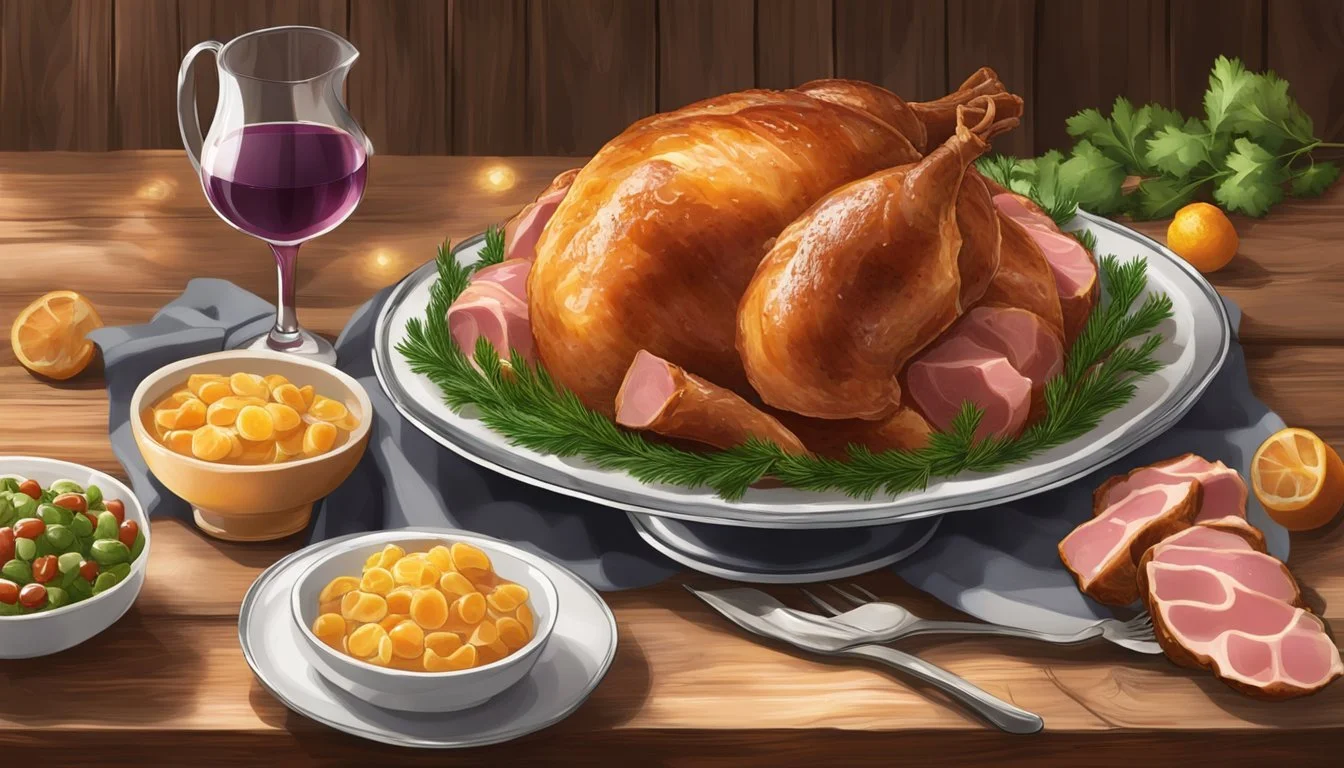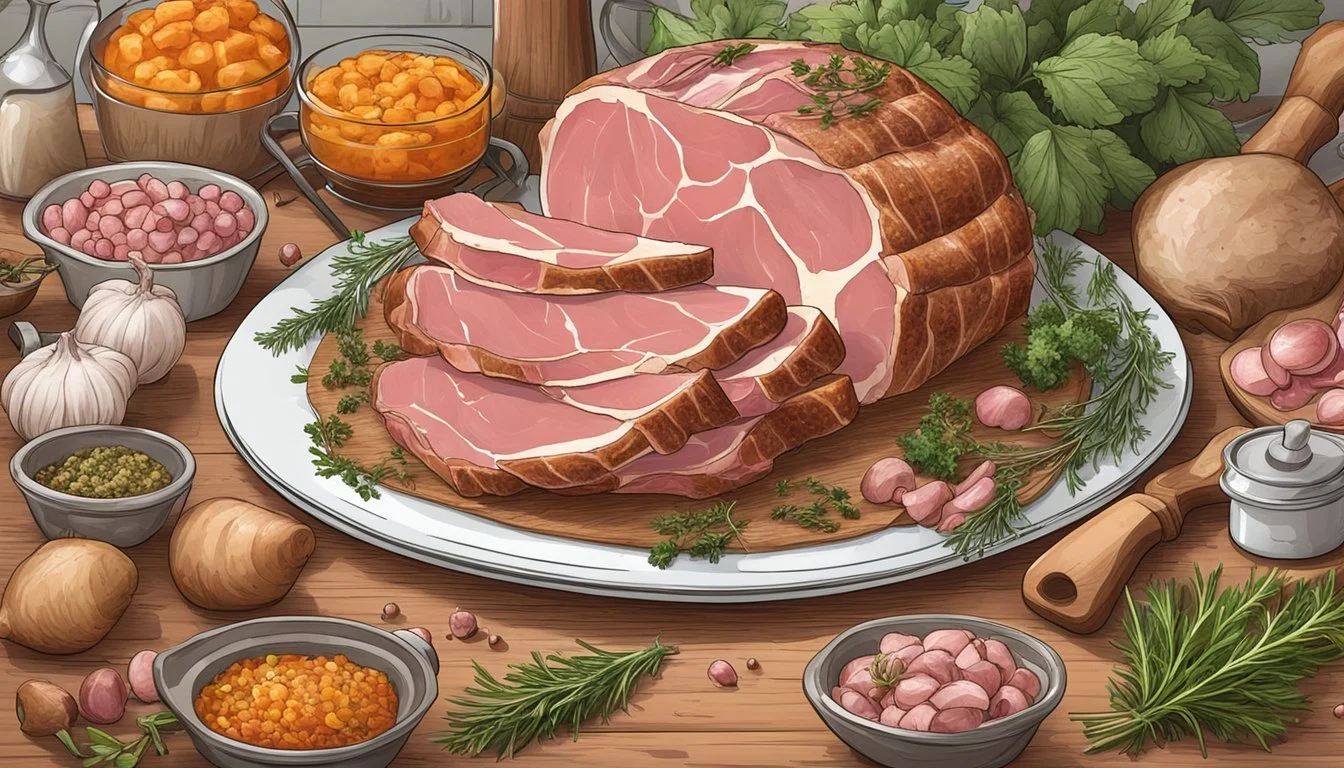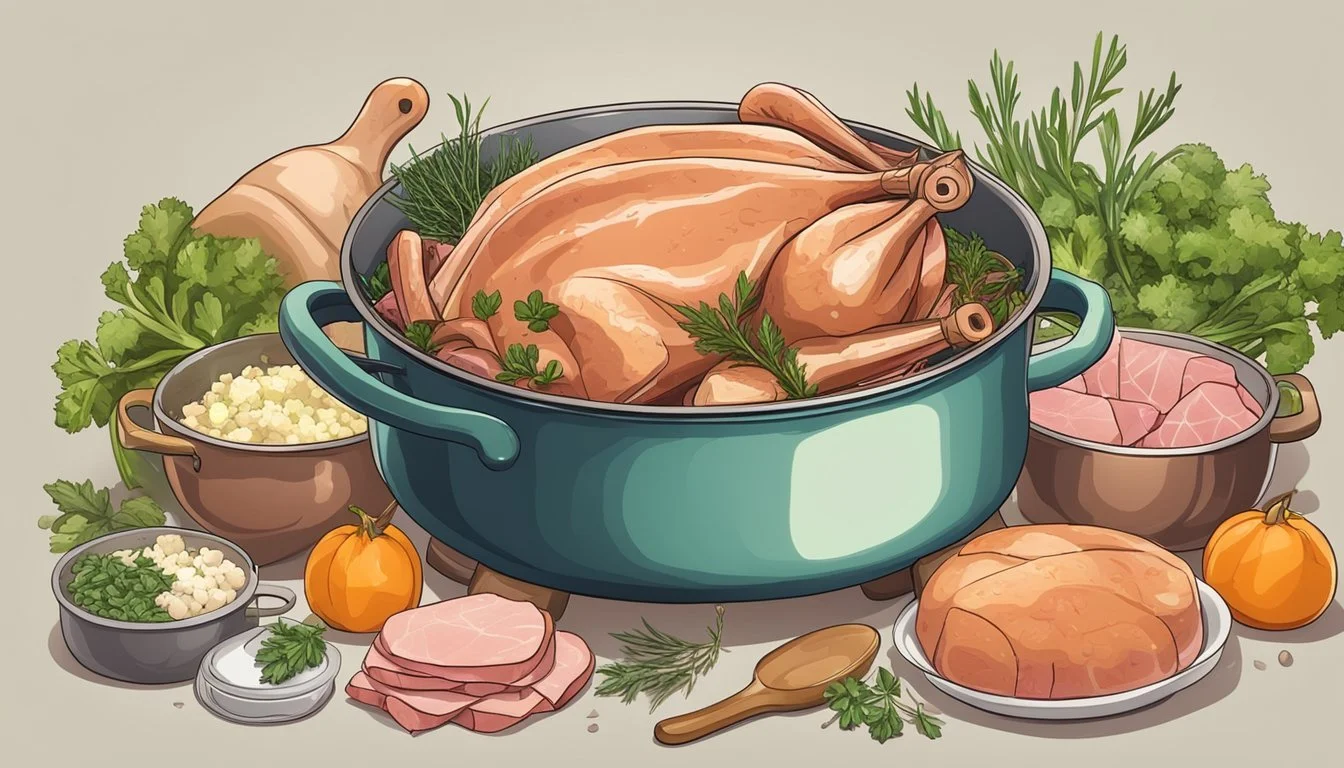Homemade Ham Hocks
Your Comprehensive Guide to Crafting Flavorful Delights at Home
Homemade ham hocks are a staple in many traditional cuisines, valued for their robust flavor and versatility. As the lower segment of the pork leg, ham hocks are typically smoked or cured, and their rich, meaty character is best extracted through slow cooking methods. This culinary ingredient is essential in dishes ranging from soulful Southern collard greens to hearty German and Polish soups, where it imparts a depth of flavor unmatched by other cuts of meat.
When preparing ham hocks at home, the process begins with proper cleaning and preparation of the meat. It's important to rinse ham hocks under cold water and pat them dry to ensure that any excess salt or surface impurities are removed. Seasoning and marinating play a crucial role in enhancing the taste, with options to customize the spice blend according to the desired dish. Whether incorporated into a smokey barbecue routine or simmered in a rich stew, ham hocks offer a foundation of taste that elevates the entire meal.
Choosing the cooking approach for ham hocks depends on the resulting texture and flavor one aims to achieve. Oven-roasting at a low temperature tends to yield a tender result, ideal for pulling the meat off the bone. In contrast, smoking infuses the ham hocks with a distinctive smoky aroma, perfect for those who appreciate a more pronounced flavor profile. Each method unlocks a different dimension of this timeless ingredient, allowing home cooks to experiment and discover the myriad ways ham hocks can enrich their culinary endeavors.
Understanding Ham Hocks
Ham hocks are a traditional cut of pork that come from a pig's hind leg, specifically from the area between the ham and the foot, known as the ankle or hough. Often considered a delicacy, they are prized for their rich flavor and are commonly used in slow-cooking dishes to add depth and a hearty meatiness.
Characteristics of Ham Hocks:
Cut: From the lower segment of the pig's leg.
Texture: Tough and fibrous, requiring long cooking times.
Flavor: Robust, smoky, and salty; varies depending on the smoking process.
Use: Essential in soups, stews, and collard greens.
Ham hocks are particularly popular in Southern cooking and soul food, as well as in German and Polish cuisines, where they contribute significantly to the dishes’ overall savoriness. Given their tough connective tissue, they are typically simmered for several hours, which gradually tenderizes the meat and releases a rich, smoky flavor.
Nutritionally, they are a source of protein, though they are also high in fat and should be enjoyed in moderation within a balanced diet. The bone within the hock can also enrich the cooking liquid with gelatin, making it a key component for cooks seeking to boost the body and texture of broths and sauces.
Selection and Preparation
The quality of homemade ham hocks begins with selection and hinges on proper preparation. Adequate storage is also crucial for maintaining freshness.
Choosing Quality Ham Hocks
When selecting ham hocks, one should look for fresh, high-quality cuts. At a grocery store or butcher, choose raw ham hocks that have a healthy pink color with a modest amount of fat. For those who prefer a more robust flavor, smoked ham hocks are available and should have a deep, rich color.
Preparing Ham Hocks for Cooking
Proper preparation of ham hocks enhances both texture and taste. Begin by rinsing them under cold water to remove surface impurities. Soaking ham hocks in cold water for at least 2 hours—preferably overnight—can help to decrease saltiness. After soaking, pat them dry with paper towels before seasoning or cooking. If making a brine, a basic mixture of 4 cups of water, 1/4 cup kosher salt, and 1/4 cup brown sugar is effective. For those interested in curing ham hocks at home, pink curing salt, also known as Prague Powder #1, is often employed in conjunction with kosher salt and sugar to foster preservation and flavor.
Storage Techniques
To preserve ham hocks, proper storage is necessary. In the refrigerator, use an airtight container to keep them fresh. To freeze ham hocks, wrap them securely in foil or place them in a freezer bag, removing as much air as possible. Ham hocks can be stored in the freezer for several months, maintaining quality when properly sealed.
Cooking Methods
Mastering various cooking methods ensures that ham hocks yield the richest flavors and optimal tenderness. The key is to choose the right technique depending on the desired texture and taste, as well as the cooking equipment available.
Boiling Ham Hocks
To boil ham hocks, submerge them in a pot of cold water. Bring the water to a simmer, not a rolling boil. This gentle cooking process can last for about 2 to 3 hours. Simmering allows the meat to become tender and flavors from seasonings or vegetables added to the pot to infuse the ham hocks.
Braising Ham Hocks
Braising involves first searing the ham hocks in a hot Dutch oven or casserole pot, creating a crispy skin. Then, they are cooked slowly in a small amount of liquid such as broth or wine, at a low temperature in the oven. Typically braised at 325°F (163°C), the ham hocks become succulent after several hours, often around 2 to 4 hours.
Smoking Ham Hocks
For smoking ham hocks, prepping the smoker to maintain a steady temperature between 225°F and 250°F is crucial. Using a variety of wood chips can impart different smoky flavors. The ham hocks are smoked until the internal temperature reaches 165°F, which usually takes about 4 to 6 hours. Smoked ham hocks should have a rich, deep flavor and can be enjoyed as is or added to other recipes.
Roasting Ham Hocks
Roasting in an oven emphasizes a crispy exterior while keeping the inside moist and tender. Placing the seasoned ham hocks in a roasting pan, ideally at a temperature of 350°F (177°C), allows for an even cook. Depending on their size, ham hocks can take 1 to 2 hours to roast. Basting during cooking can help to keep the ham hocks succulent.
Slow Cooker Technique
Using a slow cooker is a convenient method for cooking ham hocks. They are placed in the cooker with flavorings and enough liquid (broth, beer, or cider) to partially cover them. Cooked on low heat for 8-10 hours, the meat becomes exceptionally tender and may fall off the bone. This method requires minimal attention yet delivers flavorful and tender results.
Seasoning and Spices
Proper seasoning is crucial to enhance the flavor of ham hocks. Before starting the cooking process, chefs often ensure that they have a variety of seasonings and spices at hand to create a rich and savory dish.
Salt is foundational in seasoning ham hocks, providing a base level of flavor. It is also instrumental in drawing out the natural juiciness of the meat. However, one should use it sparingly, especially if the ham hocks have been previously brined, to avoid an overly salty taste.
Black peppercorns and bay leaves add layers of complexity. These two are often used whole during the cooking process. Here's how to integrate them:
Black peppercorns: They impart a sharp, aromatic heat. Crush lightly before adding to release their essential oils.
Bay leaves: One or two leaves will suffice. They contribute a subtle, herbal essence that complements the richness of the meat.
In addition to these basic seasonings, other spices can elevate the dish:
Spice Flavor Note Suggested Use Garlic Powder Warm, pungent Rub onto the meat before cooking Paprika Sweet to smoky Provide color and smokiness Thyme Earthy, slightly floral Use as part of a spice rub or add during cooking
Chefs often allow the seasonings to infuse with the meat for at least 30 minutes before cooking to ensure that each bite is flavorful. The choice of spices can be tailored according to preference, but the above combination is both traditional and popular for its balance and aromatic qualities. By thoughtful selection and application of seasonings, the simple ham hock is transformed into a delectable treat.
Recipes and Pairings
Ham hocks are a versatile ingredient that can add deep savory flavor to a variety of dishes. The following recipes showcase the traditional and international ways to pair ham hocks with beans, greens, and other vegetables to create hearty meals.
Classic Ham Hock and Beans
The time-honored combination of ham hocks and beans offers a rich fusion of salty and earthy notes. This dish is prepared by simmering ham hocks with a mix of white beans, onions, garlic, and carrots in chicken or vegetable broth until the meat is tender. A generous cooking time is the key to allowing flavors to meld.
Ingredients:
1 to 2 smoked ham hocks
1 pound dried white beans, soaked overnight
1 large onion, diced
2 carrots, diced
3 cloves garlic, minced
6 cups chicken or vegetable broth
Salt and pepper, to taste
Instructions:
Rinse and drain beans.
Combine all ingredients in a large pot and cook until beans are soft and ham hocks are tender.
Southern Style Ham Hock and Greens
In southern cooking, collard greens and ham hocks are a staple. Slowly braised together, they create a savory and slightly bitter stew. Collards are cooked with ham hocks in a pot filled with water or chicken stock, seasoned with onions and garlic, and simmered until the greens are tender and flavorful.
Ingredients:
1 smoked ham hock
1 pound collard greens, washed and chopped
1 large onion, chopped
3 cloves garlic, minced
4 cups chicken stock
Salt and pepper, to taste
Instructions:
Sauté onions and garlic in a large pot.
Add ham hock, collard greens, and chicken stock, then simmer until the greens are tender.
Ham Hock Soup Variations
Ham hock soups are a hearty option for cold days. Variations could include split pea soup with ham hocks, providing a naturally creamy and thick texture, or potato and ham hock soup for a more rustic and chunky dish. Both soups blend the savory flavor of the hocks with the natural sweetness of the vegetables like carrots, celery, and onions.
Ingredients (Split Pea Soup):
1 smoked ham hock
2 cups split peas
1 med onion, diced
2 carrots, diced
2 stalks celery, diced
6 cups chicken broth
Instructions (Split Pea Soup):
Rinse peas and combine with other ingredients in a large pot.
Cook until peas are soft and ham easily separates from the bone.
International Ham Hock Dishes
Ham hocks are enjoyed worldwide, particularly in dishes like German Eisbein, where they are braised until tender and then served with sauerkraut, or in the classic French dish Cassoulet, which combines them with beans, sausage, and duck confit. These meals explore the wide range of flavors that ham hocks can bring to international cuisine.
Ingredients (Eisbein):
2 smoked ham hocks
Sauerkraut, as needed
Potatoes, boiled and served on the side
Mustard, for serving
Instructions (Eisbein):
Braise ham hocks until tender.
Serve with sauerkraut, boiled potatoes, and mustard.
Serving and Presentation
When serving ham hocks, presentation is key to enhancing the culinary experience. One should serve ham hocks on a warm plate to maintain the temperature of the meat. Ideally, the plate should be sized appropriately to allow for both the ham hock and accompanying sides or garnishes.
Garnishes: A sprinkle of fresh herbs, such as parsley or thyme, adds a pop of color and a hint of freshness to the dish. For an aromatic touch, a garnish of citrus zest can also complement the savory flavor of the ham hocks.
Accompaniments:
Vegetables: Roasted vegetables or a side of sautéed greens complement the richness of the ham hocks.
Starches: Creamy mashed potatoes, buttered cornbread, or a rustic loaf of bread can serve as a base to soak up the succulent juices.
Presentation Tips:
Slice the meat neatly if serving off the bone. This showcases the tenderness and allows for a more elegant presentation.
Arrange the sides in a manner that showcases their colors and textures, enhancing the visual appeal of the overall dish.
Use a serving utensil that matches the aesthetic of the plateware to maintain a cohesive look.
By focusing on these aspects of serving and presentation, one elevates the dish, turning the humble ham hock into a centerpiece worthy of any dining occasion.
Health Considerations
When incorporating ham hocks into a diet, consumers should be aware of their nutritional content and the potential health implications. Ham hocks contain a significant amount of fat, particularly saturated fat, which—if consumed in excess—can lead to health problems such as heart disease.
Furthermore, ham hocks are often cured with salt, making them a high-sodium food. High sodium intake is associated with an increased risk of hypertension and cardiovascular disease. It is essential to balance recipes using ham hocks with low-sodium ingredients or to opt for reduced-sodium versions if available.
Although ham hocks do not contain sugar, they should still be used judiciously within a well-rounded diet. Their nutritional values include beneficial vitamins and minerals, such as B vitamins, iron, and zinc. Additionally, ham hocks are a source of protein which is necessary for muscle repair and growth.
In summary, while ham hocks can contribute valuable nutrients to one's diet, they should be consumed in moderation, considering their high fat and sodium content. Individuals should consult with healthcare providers to determine the most appropriate portion sizes and frequency of consumption based on their personal health goals or dietary needs.
Nutrient Consideration Fat High in saturated fat; consume in moderation Sodium Can be high in salt; opt for low-sodium versions Sugar Not present in ham hocks Nutritional Value Rich in protein, vitamins, and minerals
Homemade vs. Store-Bought
When deciding between homemade or store-bought ham hocks, consumers are considering multiple factors, including flavor, convenience, and the level of culinary skill required for preparation.
Homemade ham hocks are often favored by cooking enthusiasts who value the personal touch and control over ingredients that come with the process. Making ham hocks at home allows a cook to select high-quality cuts of meat, potentially from a local butcher, and tailor the brining process to suit individual taste preferences. Despite the time investment, homemade hocks can yield a more robust flavor profile and give a sense of accomplishment.
Preparation at Home:
Requires culinary skills and knowledge of smoking techniques
Offers the ability to customize brine solutions and smoking wood types
Involves a significant time commitment, from brining to smoking
Conversely, store-bought ham hocks are typically chosen for their convenience. Available at most grocery stores, these ham hocks have been pre-brined and smoked, cutting down on preparation time for busy households. However, this convenience may come at a cost of less control over the flavor and potential for added preservatives or flavor enhancers.
Purchasing Pre-made:
No need for specialized culinary skills
Saves time, ideal for quick meal solutions
May contain added preservatives and less customizable flavor profiles
Regardless of the choice made, both homemade and store-bought options have pros and cons that appeal differently depending on the consumer's needs, skills, and time constraints.
Tips and Tricks
When preparing ham hocks, cooks should prioritize achieving a tender result and maximizing flavors. The following tips and techniques can ensure success:
Rinsing: Always start by rinsing the ham hocks under cold water. This step is essential in removing excess salt and any impurities that might be on the surface.
Pat Dry: After rinsing, it's crucial to pat the ham hocks dry with paper towels. This prepares them for even seasoning and cooking.
Seasoning:
Let spices sit on the ham hocks for at least 30 minutes to infuse the flavor.
Common seasoning choices include:
Salt
Black pepper
Garlic powder
Paprika
Thyme
Boiling Time: Cooking times can vary:
An average ham hock (1-2 pounds) may need 1.5 to 2.5 hours to boil.
Larger ham hocks require longer, ensuring tenderness.
Braising Tricks:
For oven cooking, preheat to 325°F (163°C).
Add aromatic vegetables such as onions, carrots, and celery to the pot to enhance the taste.
Smoking Steps:
After curing in brine, rinse and dry the hocks thoroughly.
Allow to air dry in the refrigerator, uncovered, for up to 24 hours.
Smoke at low temperatures around 200°F (93°C) until the internal temperature reaches 150°F (66°C).
By adhering to these tips and techniques, chefs can achieve a harmonious balance of flavor and texture in their homemade ham hocks.
Cleaning and Maintenance
Proper cleaning and maintenance of cookware are essential in ensuring the longevity and safety of kitchen utensils, especially when preparing dishes such as ham hocks. Before and after cooking ham hocks, whether using a pot, slow cooker, or any other cookware, consider the following guidelines:
Cleaning:
Pre-Use: Rinse the ham hocks under cold water to remove surface impurities and excess salt.
Post-Cooking:
Empty the cookware and soak in warm, soapy water to loosen any stuck-on food particles.
Use a non-abrasive sponge to clean the interior and exterior surfaces of the pot or slow cooker.
Rinse thoroughly with clean water to eliminate any soap residue.
Maintenance:
Regularly inspect cookware for signs of wear or damage, such as scratches or chips, especially if using a ceramic or enamel-coated slow cooker.
Dry cookware completely before storing to prevent rust or mold growth.
Store in a dry place to avoid any moisture buildup, which can lead to deterioration.
By adhering to these cleaning and maintenance tips, one not only ensures a savory meal but also prolongs the life of their cooking implements.







